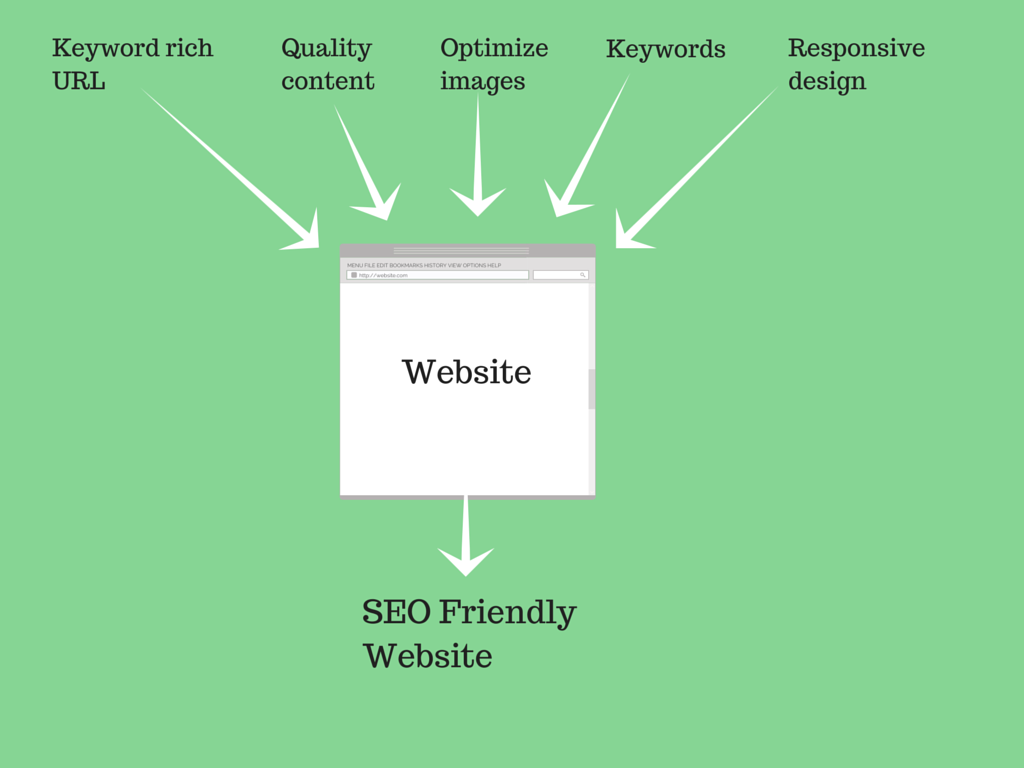How to Make Search Engine Friendly Website [CheckList]
Website is a very effective medium to represent your business or blog online. Website is a way to reach potential customers. It is necessary for your website to be attractive so that it gets attention of users & search engines. Search engines make a website visible and gives it a global presence.
So, your site must be search engine friendly otherwise search engines could ignore your site. Google & other search engines- Yahoo, Bing appreciates SEO friendly sites. Below are some points for creating a search engine friendly site.
# URL Structure
-
Website URL must be clear about what the page narrates, visitors will appreciate it.
-
Website URL should be SEO friendly to rank well in search engines.
-
URL should contain relevant keyword so both the search engines and visitors know exactly what your page is about.
-
To separate words in URL, use hyphens rather than underscores
-
For Example: A URL, such as, http://sarv.com/email-marketing/feature.php is a SEO friendly URL. But http://sarv.com/sns/?item5532 is not SEO friendly because it doesn’t help to determine what that page is about.
# Website Content
-
Content on site is most important thing. You must provide high quality, informative & original content on your web pages.
-
If your content contains useful information then it will attract many visitors & links to your site.
-
You must need to watch out for duplicate content on your site. You must avoid it because search engines give penalty to your website.
-
Long & unique content with images attracts search engines.
-
Use inbound linking, as search engines follow hyperlinks for finding the new content.
# Index-able Content
-
Firstly, you should know that search engine software could only read text.
-
If your website contains flash, images, video etc. it may look good to the human eye but it is invisible to search spiders or crawlers.
-
Crawlers can’t read these types of stuff. You should describe each image with “Alt” text.
-
Search engine can’t see your image; they can only read “Alt” text & index it for your web page.
-
If site includes video files, you should include text that describes your video.
# Properly-Optimized Images
-
Don’t forget to optimize the images on website.
-
Make sure that size of images should be minimum (30 to 100kb) to provide good user experience.
-
Big images will make website load slowly & it will negatively affect user experience & search engine ranking.
-
Include alt image text with all your site graphics.
# Title Tag
-
Every web page of your site should contain a good & unique title tag that describe content on page for visitors & search engines.
-
Title tag appears in title bar of browser window. The search engines use this tag to determine what information page contains.
-
Title tag should contain the primary keyword of your website & length of this tag should not more than 70 characters.
-
Make your title tag interesting for visitors so that they visit your site.
# Keywords
-
Keywords are the other most important things. Keywords are combination of web phrases that are used to search.
-
You must do research to find relevant keywords for your website.
-
Google offers keyword tool to find out relevant keywords for your website.
-
Make your keywords long tail (3 to 4 words), this makes competition less & you can attract more customers.
-
Place Your Keywords in many Different Places- blog posts.
Also Read: #10 On-Page SEO Factors: What Everyone Ought To Know
# Responsive Design
-
Website design should be responsive.
-
Make sure visitors can easily access your website with any device- Desktop, Mobile devices, or Tablets etc.
-
Google also give more credit to responsive websites.
-
Responsive design is more important for user experience (UX) & SEO.
-
A recent Google study revealed, “61% of mobile visitors will return to Google to find a site that is more easily readable.”
# Avoid Hidden Text
-
Some sites contain hidden pages or doorway pages which are visible to the search crawler but not for the visitors. This is a black hat SEO technique.
-
It is an illegal way for getting high rankings. If you are using this type of bad methods like doorway pages, unnatural links, low quality or duplicate content etc. then search engines will punish your website.
-
So you should always use legal & white SEO techniques. This way will take some time but you will get permanent & good results.
# Proper Use of Sitemaps
-
Be sure to include both an HTML sitemap for your website visitors, and an XML sitemap for the search engines.
-
This will ensure your visitors can locate exactly what they’re looking for, as well as ensuring complete and efficient indexation by Google.

Final Words!
These are some tips to create search engine friendly websites. Make your website in a user friendly manner so that users & search engines can’t ignore your website. Once you’ve built your site, you must continue to follow SEO best practices in terms of content, link-building and social media.
If you use search engine friendly techniques then you will get page views & good rank in search engine result page (SERP). By following the above mentioned ways you will get a healthy website for your business.
Also Read: This is How Search Engine Work [Complete Process]
Don’t forget to share your thoughts!!
Source: TLD6.com
Website is a very effective medium to represent your business or blog online. Website is a way to reach potential customers. It is necessary for your website to be attractive so that it gets attention of users & search engines. Search engines make a website visible and gives it a global presence.
So, your site must be search engine friendly otherwise search engines could ignore your site. Google & other search engines- Yahoo, Bing appreciates SEO friendly sites. Below are some points for creating a search engine friendly site.
# URL Structure
-
Website URL must be clear about what the page narrates, visitors will appreciate it.
-
Website URL should be SEO friendly to rank well in search engines.
-
URL should contain relevant keyword so both the search engines and visitors know exactly what your page is about.
-
To separate words in URL, use hyphens rather than underscores
-
For Example: A URL, such as, http://sarv.com/email-marketing/feature.php is a SEO friendly URL. But http://sarv.com/sns/?item5532 is not SEO friendly because it doesn’t help to determine what that page is about.
# Website Content
-
Content on site is most important thing. You must provide high quality, informative & original content on your web pages.
-
If your content contains useful information then it will attract many visitors & links to your site.
-
You must need to watch out for duplicate content on your site. You must avoid it because search engines give penalty to your website.
-
Long & unique content with images attracts search engines.
-
Use inbound linking, as search engines follow hyperlinks for finding the new content.
# Index-able Content
-
Firstly, you should know that search engine software could only read text.
-
If your website contains flash, images, video etc. it may look good to the human eye but it is invisible to search spiders or crawlers.
-
Crawlers can’t read these types of stuff. You should describe each image with “Alt” text.
-
Search engine can’t see your image; they can only read “Alt” text & index it for your web page.
-
If site includes video files, you should include text that describes your video.
# Properly-Optimized Images
-
Don’t forget to optimize the images on website.
-
Make sure that size of images should be minimum (30 to 100kb) to provide good user experience.
-
Big images will make website load slowly & it will negatively affect user experience & search engine ranking.
-
Include alt image text with all your site graphics.
# Title Tag
-
Every web page of your site should contain a good & unique title tag that describe content on page for visitors & search engines.
-
Title tag appears in title bar of browser window. The search engines use this tag to determine what information page contains.
-
Title tag should contain the primary keyword of your website & length of this tag should not more than 70 characters.
-
Make your title tag interesting for visitors so that they visit your site.
# Keywords
-
Keywords are the other most important things. Keywords are combination of web phrases that are used to search.
-
You must do research to find relevant keywords for your website.
-
Google offers keyword tool to find out relevant keywords for your website.
-
Make your keywords long tail (3 to 4 words), this makes competition less & you can attract more customers.
-
Place Your Keywords in many Different Places- blog posts.
Also Read: #10 On-Page SEO Factors: What Everyone Ought To Know
# Responsive Design
-
Website design should be responsive.
-
Make sure visitors can easily access your website with any device- Desktop, Mobile devices, or Tablets etc.
-
Google also give more credit to responsive websites.
-
Responsive design is more important for user experience (UX) & SEO.
-
A recent Google study revealed, “61% of mobile visitors will return to Google to find a site that is more easily readable.”
# Avoid Hidden Text
-
Some sites contain hidden pages or doorway pages which are visible to the search crawler but not for the visitors. This is a black hat SEO technique.
-
It is an illegal way for getting high rankings. If you are using this type of bad methods like doorway pages, unnatural links, low quality or duplicate content etc. then search engines will punish your website.
-
So you should always use legal & white SEO techniques. This way will take some time but you will get permanent & good results.
# Proper Use of Sitemaps
-
Be sure to include both an HTML sitemap for your website visitors, and an XML sitemap for the search engines.
-
This will ensure your visitors can locate exactly what they’re looking for, as well as ensuring complete and efficient indexation by Google.
Final Words!
These are some tips to create search engine friendly websites. Make your website in a user friendly manner so that users & search engines can’t ignore your website. Once you’ve built your site, you must continue to follow SEO best practices in terms of content, link-building and social media.
If you use search engine friendly techniques then you will get page views & good rank in search engine result page (SERP). By following the above mentioned ways you will get a healthy website for your business.
Also Read: This is How Search Engine Work [Complete Process]
Don’t forget to share your thoughts!!
Source: TLD6.com

